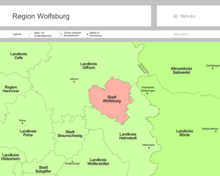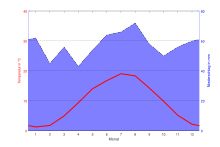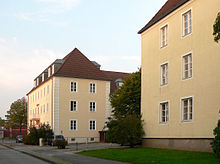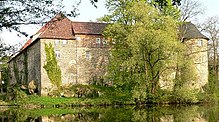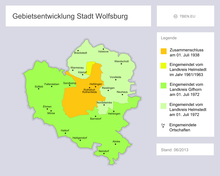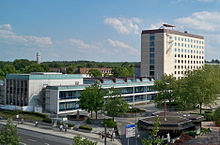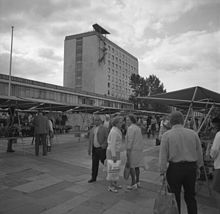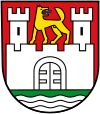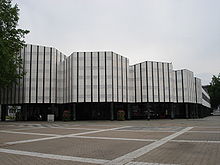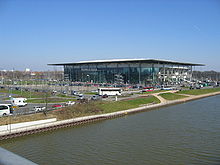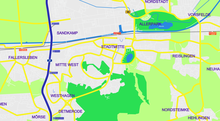Wolfsburg
| coat of arms | Germany map | |
|---|---|---|

|
Coordinates: 52 ° 25 ' N , 10 ° 47' E |
|
| Basic data | ||
| State : | Lower Saxony | |
| Height : | 63 m above sea level NHN | |
| Area : | 204.09 km 2 | |
| Residents: | 124,371 (Dec. 31, 2019) | |
| Population density : | 609 inhabitants per km 2 | |
| Postcodes : | 38440-38448 | |
| Primaries : | 05361, 05362, 05363, 05365, 05366, 05367, 05308 | |
| License plate : | WOB | |
| Community key : | 03 1 03 000 | |
| LOCODE : | DE WOB | |
| NUTS : | DE913 | |
| City structure: | 16 localities , again divided into 40 districts | |
City administration address : |
Porschestrasse 49 38440 Wolfsburg |
|
| Website : | ||
| Lord Mayor : | Klaus Mohrs ( SPD ) | |
| Location of the city of Wolfsburg in Lower Saxony | ||
Wolfsburg is an independent city in the east of Lower Saxony . The city was founded in 1938 as the headquarters of the Volkswagen factory and is the fifth largest city in Lower Saxony with around 125,000 inhabitants.
Wolfsburg is one of the few city foundations in Germany in the first half of the 20th century . Until May 1945, the city was called the city of the KdF car near Fallersleben . The city was designed as a place to live for the employees of the Volkswagen factory, where the KdF car - later the VW Beetle - was to be produced. In 1972 the population exceeded 100,000, making Wolfsburg a major city. In 2010, the gross domestic product per capita was the highest of all German cities.
Wolfsburg forms a regiopole region with the cities of Braunschweig and Salzgitter as well as one of the nine regional centers in Lower Saxony and belongs to the metropolitan region of Hanover-Braunschweig-Göttingen-Wolfsburg . The closest larger cities are Braunschweig around 26 kilometers southwest, Magdeburg around 64 kilometers southeast and Hanover around 74 kilometers west.
geography
The Aller - glacial valley with the Mittelland Canal runs in an east-west direction through Wolfsburg. The urban area encompasses the plateau of the East Brunswick lowland in the south, the Vorsfelder Werder in the north, the Barnbruch wetland in the west and the Drömling moorland in the east . The highest point is 140 meters above sea level near Almke, the lowest is 54 meters in the Ilkerbruch . The highest point in the city center is the Klieversberg at 110 meters .
climate
The annual precipitation was in the reference period between 1960 and 1990 an average of 603 mm, which was below the average of the recorded values in Germany. The driest month is February (37 mm), the most precipitation falls in June (70 mm). Precipitation hardly varies, but is highest in summer.
The annual average temperature is 8.9 ° C, the coldest month is January with an average of 0.3 ° C, the warmest is July with 18.7 ° C.
Neighboring districts and communities
The following districts , cities and municipalities border the city of Wolfsburg ( clockwise , starting in the west):
- District of Gifhorn : Calberlah , Osloß , Weyhausen , Tappenbeck , Jembke , Tiddische , Ränen
- District of Helmstedt : Danndorf , Velpke , Groß Twülpstedt , Königslutter am Elm , apprenticeship
City structure
The urban area of Wolfsburg is divided into 40 city and districts . A district alone or several districts or one or more districts together form the total of 16 localities , which are represented by local councils . Each local council has a local mayor as chairman.
Local councils were initially only formed in the districts incorporated into Wolfsburg in accordance with the Wolfsburg Act in 1972 . At that time, eleven local councils were set up. They partly took over the functions of the former city and municipal councils of these places. In 1991, additional local councils were formed for Detmerode, Westhagen and the northern part of the city, which consists of several city districts, and in 2001 the local councils were established for the city center and center-west areas, which also consist of several city districts. This means that there are now 16 local councils nationwide in Wolfsburg. These bodies are directly elected by the citizens and are to be heard on all important matters in their area.
The 16 localities (with population figures in 2015) and the associated city and districts:
- Almke-Neindorf (2.144) with the districts Almke and Neindorf
- Barnstorf-Nordsteimke (3,982) with the districts of Barnstorf and Nordsteimke
- Brackstedt-Velstove-Warmenau (3,001) with the districts Brackstedt , Velstove and Warmenau
- Detmerode (7,640), also part of the city
- Ehmen-Mörse (8,987) with the districts Ehmen and Mörse
- Fallersleben-Sülfeld (14,191) with the districts of Fallersleben and Sülfeld
- Hattorf-Heiligendorf (4.017) with the districts of Hattorf and Heiligendorf
- Hehlingen (1,854), also a district
- Kästorf-Sandkamp (1.994) with the districts of Kästorf and Sandkamp
- Mitte-West (17,942) with the districts of Eichelkamp , Hageberg , Hohenstein , Klieversberg , Laagberg , Rabenberg and Wohltberg
- Neuhaus-Reislingen (7,718) with the districts of Neuhaus and Reislingen
- Nordstadt (9,775) with the districts of Alt-Wolfsburg , Kreuzheide , Tiergartenbreite and Teichbreite
- City center (15.122) with the districts Hellwinkel , Heßlingen , Köhlerberg , Rothenfelde , Schillerteich , Stadtmitte and Steimker Berg
- Vorsfelde (12,641), also a district
- Wendschott (2,903), also a district
- Westhagen (9.206), also part of the city
Special district
The area with Volkswagenwerk and Allerpark represents a special case in the urban structure: Although it is almost in the middle of the Wolfsburg urban area, it is not assigned to a village, but is managed as a "special district". The aim of the city of Wolfsburg is to assign the Allerpark politically in the long term. However, the village of Nordstadt, like the city center, claims ownership of the Allerpark. The eastern part of the Allersee , which is located in the Allerpark, belongs politically to the village of Neuhaus-Reislingen. This is due to the old district boundaries, which were not changed by the 1972 regional reform.
Nature reserves
Eight nature reserves (NSG) are designated in the Wolfsburg city area. In the west of the Aller-Urstromtal are the areas " Allertal between Gifhorn and Wolfsburg ", " Barnbruch ", " Ilkerbruch ", " Düpenwiesen " and " Südliche Düpenwiesen ", in the east also in the Aller-Urstromtal the NSG " Wendschotter and Vorsfelder Drömling with Kötherwiesen" "And in the south the areas" Barnstorfer Wald "and" Talniederung im Barnstorfer Wald ".
See also:
- List of nature reserves in Wolfsburg
- List of landscape protection areas in Wolfsburg
- List of natural monuments in Wolfsburg
- List of protected landscape components in Wolfsburg
history
Prehistory of the city of Wolfsburg
In 1302, Wolfsburg was first mentioned in a document as the seat of the von Bartensleben family . Initially, this was a residential tower on the Aller , which only acquired its defensive character as a moated castle in later centuries . A predecessor complex was probably the Rothehof tower hill castle of the Rothehöfer line of the family , built around 1200 . Neuhaus Castle was first mentioned in documents in 1372 . After the von Bartensleben family died out in 1742, their property, including Wolfsburg, was inherited by the Counts von der Schulenburg . The count's estate was an important employer for the Rothenfelde and Heßlingen settlements near the castle and the Rothehof estate in Schulenburg .
Some of today's districts, including Heßlingen with Wolfsburg , which was independent as an estate district until 1928 , belonged to the wooden circle of the Duchy of Magdeburg in the 18th century and thus formed Prussian exclaves between two Guelph territories. It was not until 1932 that these communities were reclassified from the Gardelegen district , which now belonged to the Prussian province of Saxony , to the Gifhorn district of the (also Prussian) province of Hanover . Other districts, such as Vorsfelde and the villages that had come to Wolfsburg from the Helmstedt district , belonged to the Duchy of Braunschweig for centuries , while Fallersleben and the villages that belonged to the Gifhorn district before 1932 were part of the Electorate and, finally, the Kingdom of Hanover .
In the 18th and 19th centuries, the Braunschweig – Calvörde postal route ran across today's urban area .
Map of the area around Wolfsburg Castle around the 16th century (color recolored)
Merian engraving of the area around Wolfsburg Castle around 1654
Schlossstrasse in Alt-Wolfsburg near Wolfsburg Castle
City and factory founded as well as World War II

On May 26, 1938, Adolf Hitler laid the foundation stone for the Volkswagen factory on the north side of the Mittelland Canal, in which the KdF car was originally to be produced (later built as the VW Beetle ).
In order to accommodate the necessary workers, a new city should be built in the immediate vicinity. Therefore, with effect from July 1, 1938, the “City of the KdF-Wagons near Fallersleben” in the district of Gifhorn was formed by ordinance of the Upper President of the Lüneburg district . It consisted of the former municipalities of Rothehof-Rothenfelde and Heßlingen (including the Wolfsburg residential area ) and individual plots of land in the municipalities of Mörse (districts Mörse, Hattorf and Barnstorf), Sandkamp, Fallersleben and Hattorf, all belonging to the Gifhorn district. The center of the new city was to be built in the Heßlingen district. The construction of churches was deliberately ruled out from 1940, as Wolfsburg was to become a city without churches. Already at this time the use of foreign skilled workers was considered. The name of the Tullio-Cianetti-Halle built near the train station is reminiscent of an agreement ratified in 1937 with the Italian Mussolini government . The station on the Berlin-Lehrter Railway continued to be called Rothenfelde-Wolfsburg.
During the Second World War , the newly built car plant was primarily used for the armaments industry , including the use of thousands of slave labor . In the halls built for the production of the KdF wagons, Kübelwagen , spare parts for tanks and other armaments such as the "Retaliation Weapon 1" were produced. Concentration camp prisoners were forcibly interned in the Arbeitsdorf concentration camp and in the Laagberg satellite camp and, under inhumane conditions, were used in armaments production on the one hand, but mainly in construction work.
First phase of city development
At the end of 1937, the Society for the Preparation of the German Volkswagen (GEZUVOR) commissioned the architect Peter Koller with the planning and construction of the new city to be founded with up to 90,000 inhabitants, which was provisionally named City of the KdF-Wagons . An exemplary workers' town was to be created to serve as a model for other urban development measures in the German Reich. When building the new city, Koller was able to bypass the conventional building law restrictions, as the law created in 1937 on the redesign of German cities was applied. Starting in autumn 1937, Koller, together with the garden and landscape planner Wilhelm Heintz, developed the main features of urban development based on statistical studies of the daily needs of future city residents and on the basis of detailed topographical studies of the existing area.
In 1938, Koller became head of the town planning office and, in line with the “ Führer principle ”, was initially directly subordinate to General Building Inspector Albert Speer , and later to Robert Ley as head of the German Labor Front (DAF). In 1938 Koller submitted his draft (" Koller Plan ") for the construction of the new city, which Adolf Hitler approved after minor changes . According to the “Koller Plan”, a “city in the countryside” was planned that would adapt to the existing topography. The Mittelland Canal represented the dividing line between living and working. While the VW plant was built in the flat, tree-poor lowland area north of the canal, the south bank with slight hills and extensive forest areas was reserved for the city. On the Klieversberg as the highest point, a “town crown” with representative party buildings was planned.
Construction of the residential development with 6700 planned apartments in the first construction phase began in 1938. First, the Steimker Berg settlement was built as a residential quarter for executives from the Volkswagen factory and the city administration. Further residential buildings were built for workers in the suburbs of Wellekamp and Schillerteich . The Neuland, non-profit housing and settlement company of the German Workers' Front in the city of the KdF car was responsible for the construction.
At the end of 1941, construction work came to a standstill due to the war-related shortage of materials and labor shortages. By then, just under 2,900 apartments had been completed. In the already prepared city silhouette, barrack settlements were inserted in place of the missing permanent residential buildings . Due to the Second World War, Koller's original town planning was only partially realized. In addition to the apartments, one of the few completed construction projects is the boulevard at the CongressPark - now used as a parking lot - which, according to the original plan, was to serve as a parade street for the parades of the NSDAP below the (planned) residence of the " Führer " on the Klieversberg. Only around a hundred meters were built from the planned huge boulevard.
Koller always stated that in general not the slightest was realized or carried out from the adaptations to the "Hitler style". When Hitler spoke of a "teaching facility for urban architecture" on the occasion of the laying of the foundation stone for the city, he was shocked because he did not know of any references, ideas or descriptions that Hitler could have used as a guideline for his ideas for such a "training facility". It was only later that he realized that he “allowed himself to be carried away by the speech out of the mood and made quite irrational statements”. Koller had already not promised the plans to redesign Berlin, but in his own designs for a city of the KdF car, he was prepared to make concessions to the monumental aesthetics of National Socialism . He adapted himself to Hitler's architectural conceptions in the management of the main streets and the planned positioning of the party buildings.
1945 to 1970
At the end of the war, the city was a torso with a large number of barracks, in which mainly forced laborers, prisoners of war and concentration camp prisoners for the KdF plant were housed. On April 11, 1945, the plant was targeted by Allied air raids and two-thirds destroyed by aerial bombs .
On the evening of April 12, 1945, American tank spiers reached Fallersleben. The next day they pushed towards the Elbe without passing through what was then the “city of the KdF car”. This happened in the knowledge of the misery of such camp towns and in order not to get bogged down in skirmishes with the Volkssturm . It was only with the appearance of more American tanks on April 14, 1945 that the city was occupied without any resistance. The large number of forced laborers and prisoners of war in the barracks camps were released.
The American city commander appointed 13 city councilors on May 12, 1945 on the basis of suggestions from trade union circles. The city council met for the first time on May 25, 1945 and, at the urging of the occupying power, decided to change the previous city name from “City of the KdF car near Fallersleben” to “Wolfsburg”. This gave the city its final name after Wolfsburg Castle, which was first mentioned in a document in 1302 . The fact that the nucleus of the city already had the topographical designation "Wolfsburg" in the past , which (see above, "Prehistory of the city of Wolfsburg" ) was the official name of the manor district until 1928, contradicts the claim that Adolf Hitler's nickname "Wolf" (contains for example in “ Wolfsschanze ”) was inspiring when the city adopted the name “Wolfsburg” after the end of the Second World War.
The Volkswagen factory was initially under the direction of the British major Ivan Hirst . He prevented the dismantling of the production machines by giving the Volkswagen factory orders from the British government. It was only through these orders that the VW plant could continue to exist after the end of the war and thus trigger the growth of the city of Wolfsburg.
After the war, many displaced persons and refugees were housed in the existing barracks . In order to remedy the housing shortage in 1946–1947, the Volkswagen factory completed the as yet unfinished barracks and these were used in general. Districts of the developing industrial city emerged from earlier barracks camps without the concentration camp inmates being remembered for decades.
In 1948 the town planner and architect Hans Bernhard Reichow presented a plan for the further development of the town. It stood in the tradition of landscaping and subsequently served as a guideline for the construction of new parts of the city.
In the local elections in 1948, the right-wing German right-wing party in Wolfsburg received over 60 percent of the vote. The election was later canceled for formal reasons. On October 1, 1951, the city left the Gifhorn district and became an independent city. The coming decades were shaped by the economic miracle . This was accompanied by the rapid growth of the city and the Volkswagen factory. Wolfsburg recorded an enormous increase in the number of guest workers , mainly from Italy. Numerous representative public buildings and churches were erected, some by well-known architects.
On August 5, 1955, the one millionth Volkswagen rolled off the assembly line in Wolfsburg. This event was celebrated with a gold-colored beetle, in which numerous chrome parts are studded with cut glass beads. In 1958 the town hall was inaugurated. In 1960 Volkswagenwerk GmbH was converted into a stock corporation.
1970 until today
In the course of the Lower Saxony municipal reform of 1972, 20 places were incorporated into Wolfsburg by the Wolfsburg Act (see also incorporations ). As a result, the number of inhabitants exceeded the 100,000 limit and Wolfsburg achieved the status of a large city with almost 131,000 inhabitants; the urban area increased from 35 to 204 square kilometers. Eleven directly elected local councils, each with a local mayor, were set up for the incorporated districts . In 1973 the city had the highest population with almost 132,000.
With effect from February 1, 1978, the city of Wolfsburg was spun off from the Lüneburg administrative district and assigned to the Braunschweig administrative district , before the administrative districts in Lower Saxony were dissolved on January 1, 2005. In 1982 the city received a direct motorway connection with the A 39 as a junction from the A 2 ( Oberhausen - Hanover - Werder ) and in 1988 Wolfsburg became a university town when the state University of Applied Sciences Braunschweig / Wolfenbüttel (today: Ostfalia - University of Applied Sciences ) a location set up here.
In 1991 three more were added to the eleven local councils from 1972 (Detmerode, Westhagen and Nordstadt). Finally, in 2001 the city center and center-west councils were set up. There are currently 16 local councils in the city.
In a “sympathy rally” for the new VW Golf V , the city of Wolfsburg welcomed all visitors with the name Golfsburg on the Internet, on the city's stationery and on the town signs from August 25 to October 10, 2003 . This action received a nationwide echo in the press, on radio and television news.
In 2004 and 2012, Wolfsburg hosted the Braunschweigische Landschaft cultural festival .
Wolfsburg gained nationwide attention in summer 2009 when VfL Wolfsburg won the German soccer championship . The party celebrated in the city center with around 100,000 people was unique in the history of Wolfsburg.
In 2016 Wolfsburg was awarded the honorary title of “ European City of the Reformation ” by the Community of Protestant Churches in Europe .
In March 2019 it was announced that the north head would be redesigned in a cooperation between Wolfsburg AG and Signa Holding . The project aims to create a new city center over the next seven years.
Incorporations
With effect from July 1, 1938, the municipalities of Rothehof-Rothenfelde and Heßlingen (including the Wolfsburg residential area ) with a total of 857 inhabitants as well as numerous parcels of the municipalities of Mörse (districts Mörse, Hattorf and Barnstorf), Sandkamp, Fallersleben and Hattorf (then all districts of Gifhorn ) united to the “City of the KdF-Wagons”, in 1945 it was renamed “City of Wolfsburg”. In 1951 she left the Gifhorn district and became a district. In 1961 or 1963 - as the first formerly Brunswick area - today's Kreuzheide district was reunified from Kästorf to Wolfsburg.
On July 1, 1972, the following were incorporated :
- from the district of Gifhorn:
- City of Fallersleben (around 12,000 inhabitants)
- Municipalities of Almke, Barnstorf, Ehmen, Hattorf, Hehlingen, Heiligendorf, Mörse, Neindorf, Sandkamp and Sülfeld
- from the district of Helmstedt:
- City of Vorsfelde (around 11,000 inhabitants)
- Municipalities of Brackstedt, Kästorf, Neuhaus, Nordsteimke, Reislingen, Velstove, Warmenau and Wendschott
Population development
From around 1,000 inhabitants in 1938, the city's population rose to 25,000 by 1950 and doubled to 50,000 by 1958. With the establishment of new districts such as Detmerode and Westhagen, the population continued to grow rapidly. On July 1, 1972, the population of the city of Wolfsburg exceeded 100,000 due to the incorporation of several places, making it a major city. In 1973 the population reached its historic high of 131,971. At the end of December 2014, 123,027 people lived in Wolfsburg with their main residence, according to an update by the Lower Saxony State Office for Statistics .
The following overview shows the number of inhabitants according to the respective territorial status . These are census results (*) or official updates by the respective statistical offices or the city administration itself. The information relates to the resident population from 1938 and to the “population at the place of the main residence” since 1987.
|
|
* Census result
Religions
statistics
According to the 2011 census , 40.2% of the population were Protestant , 17.2% Roman Catholic and 42.6% were non-denominational , belonged to another religious community or did not provide any information. At the end of 2019, 39,692 (31.6%) of the 125,555 inhabitants were Protestant, 20,167 (16.1%) Roman Catholic and 65,696 (52.3%) were non-denominational or belonged to another religious community.
Christian denominations
The area of today's city of Wolfsburg belonged to the province or to the state of Hanover and the state of Braunschweig until 1946 . Therefore, the Lutheran parishes of the places in today's city of Wolfsburg also belonged to these two regional churches . This affiliation has not changed to this day. Roughly speaking, the parishes in the inner city and in the western and southern urban area belong to the Wolfsburg parish within the Lüneburg district of the Evangelical Lutheran Church of Hanover and the parishes of the eastern and northern urban area to the Provostei Vorsfelde of the Evangelical Lutheran Church in Braunschweig . A parish of the Evangelical Reformed Church is also located in Wolfsburg, as is the city mission and the Evangelical Community of Fallersleben, which belong to the Evangelical Gnadauer Community Association (communities within the Evangelical Church).
From the beginning, however, Catholics also moved to Wolfsburg. The region belongs to the diocese of Hildesheim . Wolfsburg is the seat of the dean's office Wolfsburg-Helmstedt; in addition to Wolfsburg, it also includes the Gifhorn district and most of the Helmstedt district. The parish of St. Christophorus in the city center now also includes the Catholic churches in the districts of Alt-Wolfsburg and Detmerode. The churches in the districts of Rabenberg, Westhagen and Wohltberg were closed. There is another Catholic parish each in Fallersleben and Vorsfelde.
New Apostolic churches are located in the districts of Fallersleben and Köhlerberg, their congregations belong to the church district of Braunschweig. The New Apostolic Church in Vorsfelde was given up. The Wolfsburg congregation was founded in 1950, and New Apostolic divine services were held in a Wolfsburg school barracks from 1923 onwards from the Fallersleben congregation. Furthermore, the following denominations of free church structure are represented in Wolfsburg : Seventh-day Adventists , Baptists , Pentecostals , Congregation of God , self-employed Lutherans , Mennonites , Methodists and the Apostle ministry of Jesus Christ . There are also two congregations of Jehovah's Witnesses in the city .
Other religions
The Liberal Jewish Community of Wolfsburg-Braunschweig has been in existence since February 2005 . The Orthodox Jewish community in Wolfsburg was founded in autumn 2007. The Jewish center with community headquarters and synagogue is located in Sandkamp.
The Islamic Cultural Center with the Al-Salam Mosque was opened in 2006. It was designed by the Wolfsburg architects Koller-Heitmann-Schütz. The main sponsor of the construction was the ruler of the emirate Sharjah Sultan bin Mohamed al-Qasimi . The mosque does not have a minaret . In Wolfsburg there is also the Eyup Sultan Mosque of the Turkish Islamic Community in Wolfsburg in the city center.
politics
At the head of the young "City of the KdF-Wagens" was appointed as provisional mayor in accordance with ordinance of the Upper President of the Government of Lüneburg No. 145 of June 22, 1938 with effect from July 1, 1938. His successors were also appointed by the government.
In 1946, the military government of the British zone of occupation introduced the local constitution based on the British model. Then there was a popularly elected council. This elected the mayor or lord mayor as chairman and representative of the city, who was active on a voluntary basis. In addition, from 1946 there was a full-time city director or senior city director, also elected by the council, as head of the city administration. In 2001, Wolfsburg gave up dual leadership in the city administration. Since then there has only been the full-time mayor. He is the head of the city administration and representative of the city. He has been elected directly by the people since 2001. However, the council continues to have its own chairman, who is elected from among its members at the constituent meeting of the council after each local election.
advice
The City Council is the municipal representatives of the city of Wolfsburg. Every five years citizens decide on the allocation of the 46 seats in a general, direct, free, equal and secret ballot. The following diagrams show the results of the local elections on September 11, 2016 .
|
Council election 2016
Turnout: 52.3%
% 30th 20th 10
0
29.9
24.9
17.3
10.5
7.5
3.3
3.0
1.9
1.1
0.6
Gains and losses
|
Board of Directors
The Lord Mayor is the head of administration, i.e. the superior of all employees in the city administration. He is supported by four department heads, who are elected as election officials by the council at his suggestion. Together they form the administrative board, in which the most important decisions of the administration are discussed on a weekly basis.
Mayor or Lord Mayor since 1938
| Surname | from | to | Office | Political party |
|---|---|---|---|---|
| Karl H. Bock | July 1, 1938 | December 1938 | Acting Mayor of the "City of the KdF-Wagons" | NSDAP |
| Werner Steinecke | December 1938 | 1945 | mayor | NSDAP |
| Felix Laurent | May 14, 1945 | September 30, 1945 | mayor | unknown |
| Siegfried Zaayenga | October 1, 1945 | September 25, 1946 | mayor | CDU |
| Werner Kunze | September 25, 1946 | June 12, 1947 | mayor | SPD |
| Karl Hieber | June 12, 1947 | December 20, 1948 | mayor | SPD |
| Heinrich hypocrite | December 20, 1948 | March 4, 1949 | mayor | DRP |
| Ulrich Pusch | March 4, 1949 | June 21, 1949 | State Commissioner | independent |
| Arthur Bransch | June 21, 1949 | 4th December 1953 | Mayor, Mayor from November 28, 1951 | CDU |
| Friedrich Mock | 4th December 1953 | 17th December 1954 | Lord Mayor | BHE |
| Arthur Bransch | 17th December 1954 | April 28, 1958 | Lord Mayor (2nd term) | CDU |
| Uwe-Jens Nissen | April 28, 1958 | September 18, 1961 | Lord Mayor | SPD |
| Hugo Bork | October 24, 1961 | 5th July 1972 | Lord Mayor | SPD |
| Volkmar Koehler | 5th July 1972 | November 15, 1972 | Lord Mayor | CDU |
| Hugo Bork | November 15, 1972 | August 9, 1974 | Lord Mayor (2nd term) | SPD |
| Helmut Simson | 17th September 1974 | 3rd November 1976 | Lord Mayor | SPD |
| Rolf Nolting | 3rd November 1976 | November 12, 1986 | Lord Mayor | CDU |
| Werner Schlimme | November 12, 1986 | November 6, 1996 | Lord Mayor | CDU |
| Ingrid Eckel | November 6, 1996 | February 22, 2001 | Lord Mayoress | SPD |
| Rolf Schnellecke | February 22, 2001 | December 31, 2011 | Lord Mayor | CDU |
| Klaus Mohrs | since January 1, 2012 | --- | Lord Mayor | SPD |
City directors and senior city directors 1946–2001
| Surname | from | to | Office | Political party |
|---|---|---|---|---|
| Johannes Dahme | August 1, 1946 | June 30, 1950 | City Director | SPD |
| Otto Grimm | May 15, 1950 | October 31, 1951 | City director, from October 1, 1951 senior city director | independent |
| Walter Wegener | February 1, 1952 | May 9, 1953 | City Director | independent |
| Wolfgang Hesse | October 1, 1953 | October 31, 1964 | City Director | CDU |
| Günter Balk | February 16, 1965 | October 11, 1973 | City Director | independent |
| Werner Hasselbring | 23rd January 1974 | 22nd September 1982 | City Director | SPD |
| Peter Lamberg | May 1, 1983 | April 30, 1995 | City Director | CDU |
| Rolf Schnellecke | May 1, 1995 | February 21, 2001 | City Director | CDU |
Indebtedness
The total amount of debts in the public sector of the city of Wolfsburg amounted to 317.4 million euros at the end of 2012. Each resident was thus in debt with 2616 euros. Of the 103 independent cities in Germany, Wolfsburg was 90th in terms of per capita debt.
Planned mergers
On March 13, 2013, the council unanimously decided to start merger negotiations with the Helmstedt district . The aim of the negotiations should be the dissolution of the Helmstedt district and the formation of a community association in Wolfsburg. On the same day, it was also unanimously decided to start merger negotiations with the neighboring city of Königslutter for the purpose of incorporation into the city of Wolfsburg. The merger plans in the form of a community association Wolfsburg-Helmstedt were rejected by the state of Lower Saxony as incompatible with the Lower Saxony constitution. However, neither the district council of the Helmstedt district nor the council of the city of Wolfsburg have taken a decision to officially declare the merger negotiations over. In this respect, the merger talks are on hold until further notice.
coat of arms
The draft arms of Wolfsburg comes from the in Isernhagen born and later in Hannover living heraldry and crest painter peoples Gustav , who has the crest of mountains , Salzgitter , Wunstorf has designed and many other towns in Lower Saxony. The coat of arms was introduced in 1947 by the main statute, after a stylistic simplification was approved by the city council on March 23, 1950 and approved by the Lower Saxony Minister of the Interior on May 23 of the same year . In 1952 it was slightly revised with renewed ministerial approval on September 20, and again in 1960/61 with renewed, albeit superfluous, approval from the Lüneburg District President on March 7, 1961; At first the open castle gate was black with a golden portcullis, now it is silver and closed. This graphic change was carried out by Klaus Grözinger .
| Blazon : "In red over a green shield base coveredwith three silver corrugated beams , a two-towered silver castle , on the battlements of whicha golden , blue-tongued , resisting wolf walksto the right over a closed gate ." | |
| Justification of the coat of arms: The coat of arms with the wolf and the castle is self-explanatory (so-called talking coat of arms ); the latter is also reminiscent of Wolfsburg Castle , which can be traced back to 1135. The red field symbolizes the former municipality of Rothehof-Rothenfelde , another original cell of the city. Finally, the waves are those of everyone . |
Further coats of arms and city logo
- The city flag was introduced in 1955.
- The Wolfsburg coat of arms is used for official and sovereign events.
- In image campaigns, the city presents itself with the name of the city, the wolf.
| banner | Flag, coat of arms and logo |
|---|---|

|
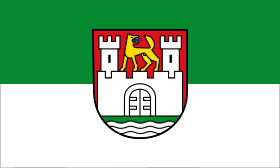
|

|
Town twinning
The city of Wolfsburg maintains the following city partnerships :
-
 Marignane , France (since 1963)
Marignane , France (since 1963) -
 Province of Pesaro and Urbino , Italy (since 1975)
Province of Pesaro and Urbino , Italy (since 1975) -
 Halberstadt , Germany (since 1989)
Halberstadt , Germany (since 1989) -
 Togliatti , Russia (since 1991)
Togliatti , Russia (since 1991) -
 Bielsko-Biała , Poland (since 1998)
Bielsko-Biała , Poland (since 1998) -
 Jiading (District of Shanghai ), People's Republic of China (since 2015)
Jiading (District of Shanghai ), People's Republic of China (since 2015) -
 Jendouba , Tunisia (city friendship since 2010, city partnership since 2019)
Jendouba , Tunisia (city friendship since 2010, city partnership since 2019)
Former twin town:
-
 Luton , United Kingdom (1950-2004); declared finished by Wolfsburg.
Luton , United Kingdom (1950-2004); declared finished by Wolfsburg.
City friendships
-
 Sarajevo , Bosnia and Herzegovina (since 1985)
Sarajevo , Bosnia and Herzegovina (since 1985) -
 Changchun , People's Republic of China (since 2006)
Changchun , People's Republic of China (since 2006) -
 Puebla , Mexico (since 2010)
Puebla , Mexico (since 2010) -
 Toyohashi , Japan (since 2011)
Toyohashi , Japan (since 2011) -
 Dalian , People's Republic of China (since 2011)
Dalian , People's Republic of China (since 2011) -
 Chattanooga , United States (since 2011)
Chattanooga , United States (since 2011) -
 Popoli , Italy (since 2012)
Popoli , Italy (since 2012) -
 Nanhai (District of Foshan ), People's Republic of China (since 2016)
Nanhai (District of Foshan ), People's Republic of China (since 2016)
Consular missions
Culture and sights
Regional associations
The city of Wolfsburg is a member of the Braunschweigische Landschaft e. V. based in Braunschweig and in the Lüneburg Landscape Association e. V. based in Uelzen. These associations were founded to maintain cultural institutions in the regions.
Theaters and event centers
- The Scharoun Theater , built according to plans by the architect Hans Scharoun , opened in 1973. It offers 777 seats for musical theater performances and 833 seats for drama . Every year there are about two own productions, otherwise it is a venue for touring theater and other guest performances.
- The Wolfsburg Puppet Theater Compagnie in the Bollmohr barn in Heßlingen
- The gallery theater in Heßlingen
- The wooden bench theater in Reislingen
- The CongressPark in the city center
- The indoor swimming pool - culture on Schachtweg in the city center
- The Wolfsburg Dancing Theater in the indoor pool - culture on Schachtweg
- The magic theater UNIKUM (Small Stage Hoffmannhaus ) in Fallersleben (until 2016)
- The Autostadt with numerous venues
Museums
Significant structures

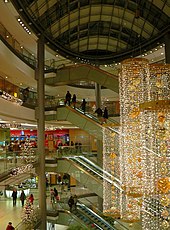
- The Wolfsburg , a Weserrenaissance -Schloss from the 13th century, first mentioned in 1302 as the seat of the noble family of the von Bartensleben , gave the city its name. The castle has belonged to the city since 1961 and is home to the city museum, the city gallery, the Wolfsburg art association , the learning workshop and the Heidersberger Institute with changing exhibitions. The complex, which came into the possession of the Prussian noble family von der Schulenburg in the 18th century, is the oldest and most important building in terms of art history. It is therefore considered a symbol of the city.
- Neuhaus Castle in the Neuhaus district is a medieval moated castle from the 14th century and has been owned by the city since 1981.
- Fallersleben Castle is located in the Fallersleben district , a castle completed in 1551 that was the widow's seat of the Duchess Clara zu Gifhorn . It is located in the immediate vicinity of the old town of Fallersleben and has been home to the Hoffmann von Fallersleben Museum since 1991 . The old brewery and the Michaeliskirche are also located near the castle .
- In addition to Fallersleben, Vorsfelde also has a historical center with numerous listed buildings ( see: List of architectural monuments in Vorsfelde ), including the St. Petrus Church and the beekeeping house .
- In 1958 the town hall was inaugurated on the market square in the southern section of Porschestrasse . In 1990 the Südkopf was expanded, with the “Südkopf-Center” shopping arcade (also called the “ship” by the Wolfsburgers because of its shape). Wolfsburg's “Kulturmeile” (cultural mile), consisting of the Scharoun-Theater, CongressPark (formerly: Stadthalle), planetarium , Alvar-Aalto-Kulturhaus (with city library) and the art museum, which opened in 1994, is also located at the Südkopf . In 1994 the town hall was expanded to include "Town Hall B".
- The Finnish architect and designer Alvar Aalto built the Alvar-Aalto-Kulturhaus with library, the Heilig-Geist-Kirche with community center in the Klieversberg district and the Stephanuskirche in the Detmerode district in Wolfsburg . The architect Hans Scharoun designed the theater (today Scharoun Theater ).
- In the city center, the previously passable middle section of Porschestrasse was redesigned into a pedestrian zone from 1977 to 1980 . The main shopping area in the city center is divided into three parts: Porschestrasse-Nord (with the " Nordkopf "),-Mitte and -Süd (with the "Südkopf"). Porschestrasse-Mitte offers a water landscape and plenty of seating. The “City-Galerie” shopping arcade, completed in 2001, with around 100 shops is also located in this section of the pedestrian zone.
- The Autostadt (north of the Mittelland Canal) and the CinemaxX were opened in Wolfsburg in 2000 , and in 2002 the new Volkswagen Arena east of the Autostadt.
- In November 2005 the phæno , an interactive science museum, opened. The architecturally extraordinary building was designed by Zaha Hadid . 250 experiment stations are set up on almost 9,000 m² of exhibition space, which make scientific phenomena tangible. The construction costs amounted to around 80 million euros.
- Next to the Volkswagen Arena are the EisArena , the home stadium of the Wolfsburg Grizzlies , the " BadeLand " and the Allersee in the Allerpark .
- The Designer Outlets Wolfsburg , or DOW for short, opened on December 15, 2007. Since an expansion, the sales area is 16,000 m².
Other cultural institutions and groups
- The Italian Consular Agency in Wolfsburg has a cultural department and participates in the city's cultural life with concerts, exhibitions and seminars.
- The bands Protector and Oomph! were founded in 1986 and 1989 in Wolfsburg.
- The second Lower Saxony State Horticultural Show took place in the city of Wolfsburg from April 23 to October 10, 2004 .
- The dolphin cinema has been open to the public again since 2009.
Churches
- Not far from the pedestrian zone are the two main churches of the city center, the Evangelical Christ Church and the Catholic St. Christophorus Church . The St. Petrus Church in Vorsfelde is the main church of the Provosty Vorsfelde .
Regular events


- seasonal: ice hockey (Grizzlys Wolfsburg) in the ice arena ; Football Bundesliga in the Volkswagen Arena (men) and in the AOK Stadium (women)
- January February:
- Wedding fair in the CongressPark Wolfsburg
- May:
- Shooting and folk festival in Allerpark (around 350,000 visitors per year)
- Campus Open Air at Robert-Koch-Platz, project of the music forge at the Ostfalia University of Applied Sciences
- every two years the Drömling fair on the Bürgerplatz and in the Schützenhaus Vorsfelde
- June: International Summer Stage ( Wolfsburg Castle )
- June / July: Garden romance at Wolfsburg Castle
- July / August: Jazz 'n' more, open-air concerts in the pedestrian zone
- July / August: Movimentos - International dance festival at KraftWerk / Autostadt and other event locations in the region (formerly April / May)
- August:
- Rock im Allerpark - open air rock festival
- Old town festival in the old town of Fallersleben
- Boar festival in the old town of Vorsfelde
- August / September: Gourmet Festival four-day music / cultural event with culinary delights
- October:
- Autumn market of the artisans at Neuhaus Castle
- Every two years the IZB ( International Supplier Exchange ), the largest automotive supplier exchange in Europe in Allerpark
- November / December: Christmas markets in the city center, in the Autostadt, in Wolfsburg Castle and in various places in the city
Culinary specialties
A well-known dish from Wolfsburg is the VW currywurst . The Wolfsburg-based company dinner is a currywurst that has been prepared by Volkswagen's own business since 1973, or the accompanying curry sauce, which is typically warm curry sauce, prepared according to a secret recipe. 80 percent of the sausages are consumed in the canteens of the German VW factories. The great popularity of sausage and sauce has meanwhile mean that they can also be bought outside the Volkswagen factory. In Berlin she can now be seen in the museum. In 2014, 6.3 million VW curry sausages were produced.
freetime and sports

leisure
- The phæno is one of the largest science centers in Germany.
- The largest adventure pool in northern Germany, BadeLand , is located in the Allerpark .
- The Autostadt , a theme park all about cars and machines, is located north of the Mittelland Canal, not far from the main train station and the city center.
- In the Allerpark there is the only six-mast water ski facility in Europe in the so-called “Arena Lake” and right next door is the largest skateboard fun box in Europe.
- Wolfsburg has many city parks, for example the castle parks in Alt-Wolfsburg and Fallersleben, the Klieversberg, the Allerpark and the Schillerteich-Park. Sometimes there is the possibility of cross golf . Overall, the public parks in Wolfsburg are twice as large as Central Park in New York City. In the south of the city lies the extensive city forest, in the east the Drömling and in the west the Barnbruch , which also serve as local recreation areas.
- The indoor pool - culture on Schachtweg in the former indoor pool is one of the largest cultural centers in northern Germany. In addition to concerts, cabaret and art house cinema, the house offers a wide range of activities for young people (practice / rehearsal rooms) and children (childcare)
- The Hygia X-perience Park in the Allerpark offers many play and sports opportunities.
- The Planetarium Wolfsburg is 15 meters diameter dome, the largest planetarium in Lower Saxony. Technically, it is one of the most modern in the world thanks to Zeiss Velvet projectors and the Evans & Sutherland Digistar 5 .
- The VW-Bad is an outdoor swimming pool that is a listed building.
- In addition, there are several theaters in Wolfsburg (see above), many museums, riding facilities, sports fields, youth centers, stadiums and the like.
Sports
- Wolfsburg is represented in the first leagues by the men's and women's football teams of VfL Wolfsburg (in the Bundesliga and women's Bundesliga ). The men's team has been consistently represented in the 1st Bundesliga since 1997, became German champions for the first time in the 2008/09 season and won the DFB Cup in 2014/15 . The women are three times German champions, four times cup winners and have won the Champions League twice . The ice hockey team of Grizzlys Wolfsburg plays in the German Ice Hockey League (DEL) .
- In the amateur area, Wolfsburg is also strongly represented in other American sports. In addition to the American Football Club Blue Wings , Wolfsburg Yahoos ( baseball ) and the next generation of ice hockey, the Young Grizzlys from EHC Wolfsburg. The Wolfsburg Honeybees are successful in women's cheerleading - among other things, they were runner-up in Japan in 2001. The PBSG Wolfsburg has been playing in the 2nd Bundesliga pool since 2014 .
Economy and Infrastructure
Economic data and resident companies
Wolfsburg has around 120,000 jobs. Over 78,000 commuters (as of 2018) work in the city. In 2016, the gross domestic product (GDP), within the city limits, was 22.155 billion euros, making it 13th in the ranking of German cities by economic output . In the same year, GDP per capita was € 178,706 per capita (Lower Saxony: € 34,812 / Germany € 38,180). Wolfsburg thus had the highest GDP per capita of all independent cities in Germany and was also one of the richest cities in the world. The unemployment rate in Wolfsburg was 4.4% in December 2018 and thus below the Lower Saxony average of 5.0%. In the Future Atlas 2016 , the city of Wolfsburg was ranked 5th out of 402 rural districts and cities in Germany, making it one of the regions with “top future opportunities”.
By far the largest employer is Volkswagen AG , which employs over 50,000 people in administration and the factory. Thanks to the Volkswagen factory and the many suppliers in Wolfsburg and the surrounding region, the economy is strongly geared towards the automotive industry. In order to move Wolfsburg away from this mono-industry, which is very susceptible to crises in the automotive sector, Stadt and Volkswagen AG founded Wolfsburg AG in 1999 . The concept provides for the development of sustainable economic and employment prospects at the Wolfsburg location.
Other Wolfsburg-based companies also mostly focus on the automotive industry. The international IT service provider H&D International Group , which is also active in the banking, utilities and healthcare sectors, is also based here. Other companies such as Sitech and Volkswagen Group Services are based in the city as VW subsidiaries. One of the ten largest German logistics companies, the Schnellecke Group , which is owned by the former mayor Rolf Schnellecke , achieved sales of EUR 835 million in 2012 and employs almost 19,000 people. In addition, the largest system hairdresser in Germany, Frisör Klier , is based here.
Transport links
Rail transport
The Wolfsburg Central Station is located on the Hanover-Berlin high-speed railway . It is used by Intercity Express trains on the Berlin - Braunschweig - Kassel - Frankfurt (Main) - Mannheim - Karlsruhe - Basel - ( Bern - Interlaken ) and Berlin - Hanover - Hamm - Cologne (- Bonn ) / Düsseldorf (- Cologne / Bonn Airport ) every two hours. Intercity trains also stop here on the Berlin - Stendal - Hanover - Amsterdam route every two hours. With a CityNightLine train , Zurich , Brussels and Paris , among others , could be reached without changing, but this service was discontinued by Deutsche Bahn in 2016.
In regional traffic stop here regional trains of Abellio Rail Central Germany usually every hour toward Oebisfelde - Stendal as well as Oebisfelde and Haldensleben to Magdeburg at least every two hours. Abellio Rail Mitteldeutschland operates on these routes with Alstom Coradia LINT trains. With the RE30 there is an hourly connection to the state capital Hanover via Gifhorn . The RE50 line, like the RE30 operated by the Metronom Eisenbahngesellschaft under the brand name enno , connects Wolfsburg Central Station with Hildesheim Hbf via Braunschweig Hbf every hour .
In the west of the city is the Fallersleben separation station , near which the railway line to Braunschweig ( Weddeler Loop ) branches off, which is also used by ICE trains. Regional trains in the direction of Braunschweig and Hanover stop in Fallersleben. In addition, a double-track, non-electrified line branches off to the Volkswagen factory here.
The Vorsfelde stations on the line towards Stendal and Ehmen on the Braunschweig line were closed in the 1970s, as was the Almke and Neindorf stations on the Schandelah – Oebisfelde line when this line was closed.
Road traffic
The A 39 runs through the western urban area of Wolfsburg, starting north of the city near Weyhausen (Gifhorn district) and heading south to the A 2 ( Oberhausen - Werder near Berlin). The continuation of the A 39 as a direct connection to Braunschweig, Salzgitter and the A 7 was completed at the beginning of 2009. There are also plans to build the A 39 further north near Weyhausen to Lüneburg on the northern part of the A 39, which leads to the Maschener Kreuz south of Hamburg .
In addition, the B 188 Burgdorf - Friesack and the B 248 Northeim - Dannenberg , which has largely been replaced by the A 39 in the city, run through Wolfsburg.
The “Berliner Ring” represents a kind of city periphery, which surrounds the city center with a four (sometimes also six) lane street and numerous, also multi-lane junctions, e.g. B. to Braunschweiger Strasse and Heinrich-Nordhoff-Strasse. All important places within Wolfsburg can be reached via the Berliner Ring / Braunschweiger Straße.
Transportation
Local public transport in the city of Wolfsburg is served by numerous bus routes operated by Wolfsburger Verkehrs GmbH (WVG) with a passenger volume of around 12.8 million passengers per year. There has been a new bus network since October 26, 2014.
shipping
Large quantities of freight are transported on the Mittelland Canal . Shipping of all stripes is served at the ports of Wolfsburg .
Air traffic
The Braunschweig-Wolfsburg Airport , located in Braunschweig Waggum located is largely of private planes and companies (eg. As Volkswagen Airservice used). There are no scheduled flights. It is the second largest research airport in Europe. The nearest commercial airport is Hannover-Langenhagen Airport in Langenhagen .
media
- freischwimmer (city magazine, appears five times a year, until February / March 2016)
- hello Wolfsburg (until September 2014 Wolfsburger Rundblick ) (Saturday newspaper, free)
- indigo (city magazine, published monthly until December 2015)
- Neue Wolfsburger (Wednesday newspaper, free)
- TV38 - TV station of the region (formerly: OKTV ) with headquarters and broadcasting center in Westhagen
- viseo (online magazine)
- wobfreunde ( city magazine , published every six months in June and November, free of charge)
- wobstories.tv (Internet television with Wolfsburg reports and documentaries)
- Wolfsburg live (city magazine, appears every two months)
- Wolfsburger Allgemeine Zeitung - WAZ (daily newspaper)
- Wolfsburger Blatt (Internet newspaper )
- Wolfsburger Kurier (Sunday newspaper, free)
- Wolfsburger Nachrichten - WN (daily newspaper)
Public facilities
- Wolfsburg Waste Management and Street Cleaning (WAS)
- Wolfsburg Drainage Company (WEB)
-
Wolfsburg City Hospital
- Center for Developmental Diagnostics and Social Pediatrics (ZEUS)
- Institute for Clinical Pathology
- Institute for Clinical Chemistry, Laboratory and Transfusion Medicine
Education and Research
Educational institutions
- Colorful elementary school
- Elementary school on Drömling
- Elementary School Alt-Wolfsburg
- Ehmen-Mörse elementary school
- Eichendorff School
- Fallersleben primary school
- Friedrich von Schiller School
- Hasenwinkel primary school
- Heidgarten elementary school
- Schunterwiesen primary school
- Hellwinkel School
- Bug school
- Laagberg School
- Rainbow School
- Sülfeld primary school
- Eichelkamp Forest School
- Wendschott primary school
- Wohltberg Elementary School
- Two special schools
- Special school for physical and motor development (primary level: Friedrich-von-Schiller-Schule location; secondary level: Vorsfelde school center)
- Peter Pan School (special school with a focus on intellectual development)
- Two main schools
- Fallersleben secondary school
- Vorsfelde secondary school
- Hoffmann von Fallersleben Secondary School
- Realschule Vorsfelde
- Two high schools
- Eichendorff School
- Wolfsburg High School

- Seven high schools
- Albert Schweitzer High School
- Eichendorff School
- Fallersleben high school
- Phoenix High School
- Council high school
- Theodor-Heuss-Gymnasium
- Wolfsburg College ; a high school for adults to catch up on the Abitur
- Heinrich Nordhoff Comprehensive School ( Integrated Comprehensive School )
- Leonardo da Vinci comprehensive school (integrated comprehensive school with primary level and German-Italian branch)
- Free Waldorf School , comprehensive school with primary level; Independent alternative school
- New School Wolfsburg, comprehensive school with primary level; Independent alternative school
- Four vocational schools
- Carl Hahn School (specialization: economics / administration and health)
- BBS 2 (specialization: commercial-technical)
- BBS Anne-Marie-Tausch (specialization: education, care and therapy)
- Vocational school cosmetics / Oskar Kämmer school
- Others
- Music school of the city of Wolfsburg
- Wolfsburg Adult Education Center
- Wolfsburg City Library
- Institute for Contemporary History and City Presentation
- Evangelical Family Education Center (FABI)
Colleges
- Since 1988, the Ostfalia University of Applied Sciences has been located in Wolfsburg , which was created in 1971 through the merger of the Wolfenbüttel State Engineering School with the Higher Technical School for Social Work of the State of Lower Saxony. The other locations of the university are Wolfenbüttel , Salzgitter and Suderburg . The university was expanded in 2005 for 25 million euros, as there is always a considerable excess of applicants.
- Faculty of automotive engineering
- Faculty of Healthcare
- Faculty of Business
- Institutes of the Ostfalia University of Applied Sciences in Wolfsburg:
- Wolfsburg Institute for Vehicle Construction
- Institute for Recycling
- Institute for Vehicle Informatics and Vehicle Electronics
- Wolfsburg Institute for Business and Corporate Development V.
- The AutoUni is a company-owned educational institution of Volkswagen AG (VW) in the city of Wolfsburg. It was founded in 2002 and opened in 2007. For the time being, educational programs are to be offered for postgraduates, until 2008 exclusively for members of the VW Group.
- Department for "Mobility"
- Department for "Sustainability"
- Department for "Health"
- "Leadership and Service" department
Research and Institutes
- Institute for Clinical Pathology
- Center for Developmental Diagnostics and Social Pediatrics (ZEUS)
- Institute for Clinical Chemistry, Laboratory and Transfusion Medicine
- The Wolfsburg City Clinic is the academic teaching hospital of the Hannover Medical School (MHH) and one of the largest in Lower Saxony; it has a catchment area of more than 180,000 people and is the second largest employer in the city of Wolfsburg.
In 2003 over 26,000 people learned and studied at Wolfsburg schools and institutes (and the trend is rising).
In October 2003 the Fraunhofer ICT's Sustainable Mobility project group was founded. The primary goal of the project group is to strengthen applied research in the areas of materials, products and processes.
Honorary citizen
The city of Wolfsburg has granted honorary citizenship to 20 people since it was founded. Three other honorary citizens of the former cities of Fallersleben and Vorsfelde were taken over in the course of their incorporation on July 1, 1972.
Famous pepole
- Hans von Bartensleben ( Hans the Rich , 1512–1583), religious arbitrator, palace builder, poor benefactor
- Gebhard Werner von Bartensleben (1675–1742), owner of Wolfsburg Castle
- Anna Adelheit Catharina von Bartensleben (1699–1756), owner of Wolfsburg Castle
- Gebhard Werner Graf von der Schulenburg (1722–1788), court marshal at the Prussian court under Frederick the Great , founder of the Wolfsburg line of Count von der Schulenburg, born and raised at Wolfsburg Castle in what is now the Alt-Wolfsburg district
- Gebhard von der Schulenburg-Wolfsburg (1763-1818), owner of Wolfsburg Castle, president of the imperial estates in the Kingdom of Westphalia and leading politician in the Duchy of Braunschweig
- Werner von der Schulenburg-Wolfsburg (1792–1861), entertainer of Wolfsburg Castle and builder of the Rothenfelde colony
- Hoffmann von Fallersleben , bourgeois August Heinrich Hoffmann (1798–1874), Germanist, linguist, librarian, (song) poet (“ The German song ”), born and raised in what is now the Fallersleben district
- Günther von der Schulenburg (1819–1895), owner of Wolfsburg Castle and member of the Prussian manor house
- Heinrich Büssing (1843–1929), vehicle designer, major entrepreneur, born and raised in what is now the Nordsteimke district
- Werner-Karl-Hermann Graf von der Schulenburg-Wolfsburg (1857–1924), entails master of Wolfsburg Castle and member of the Prussian manor house
- Hanns Kerrl (1887–1941), politician (NSDAP), born and raised in what is now the Fallersleben district
- Günther Graf von der Schulenburg-Wolfsburg (1891–1985), entertainer of Wolfsburg Castle, honorary citizen
- Gustav Kurt Beck (1902–1983), Austrian painter, worked in Wolfsburg for a long time until his death
- Titus Taeschner (1905–1997), architect and urban planner, lived and worked in the city for a long time
- Heinrich Heidersberger (1906–2006), artist, photographer, honorary citizen, lived in Wolfsburg from 1961 until his death
- Peter Koller (1907–1996), NSDAP member, architect and town planner, significantly involved in the planning and construction of the city

- Horus Engels (1914–1991), artist, sculptor, lived and worked in Wolfsburg
- The Frauenort in Wolfsburg was dedicated to Sibylle von Schieszl (1918–2010), physicist and manager in the automotive industry
- Peter Szaif (1923–1970), sculptor, lived in Wolfsburg and created numerous works of art in public spaces
- Hermann Kracht (1929–2011), sculptor, lived and worked in Wolfsburg
- Volkmar Köhler (1930–2012), former Lord Mayor and Councilor of the City of Wolfsburg, former Parliamentary State Secretary in the Federal Government, honorary citizen
- Dorothea Chabert (* 1931), ceramic artist, lived at Wolfsburg Castle from 1972 to 2015
- Arnulf Baumann (* 1932), clergyman and former head of the Diakonisches Werk in Wolfsburg, representative of the Bessarabian Germans, holder of the Federal Cross of Merit
- Günzel Graf von der Schulenburg-Wolfsburg (1934–2018), farmer and forester, entrepreneur and equestrian, was born at Wolfsburg Castle and lived in what is now Nordsteimke from 1945 until his death
- Rudolf Graf von der Schulenburg-Wolfsburg (* 1937), BMW Manager and President of the Automobile Club of Germany , born in Wolfsburg
- Ilse Schwipper (1937–2007), anarchist feminist and founder of the Wolfsburg municipalities of Bäckergasse and K 3
- Gottfried Munzenberg (* 1940), physicist, grew up in Wolfsburg
- Rolf Schnellecke (* 1944), Lord Mayor 2001–2011, honorary citizen, born in the city of the KdF-Wagen, today Wolfsburg
- Rolf-Dieter Postlep (* 1946), economist and President of the University of Kassel since 2000 , born in Wolfsburg
- Wolfgang Wolter (1947–2005), actor, born and raised in Wolfsburg
- Rainer Marggraf (* 1949), environmental economist, born in Wolfsburg
- Matthias Mülmenstädt (* 1949), Ambassador to Lithuania, born in Wolfsburg
- Lothar Krist (* 1951), jazz musician, born in what is now the Fallersleben district
- Margit Müller (* 1952), world hockey champion, worked as an athlete and teacher in Wolfsburg
- Christine Kramer (* 1954), lawyer, State Councilor of the Free Hanseatic City of Bremen
- Gabriele von Lutzau (* 1954 in Wolfsburg as Gabriele Dillmann), artist and sculptor, stewardess during the hijacking of the "Landshut" plane , which was celebrated by the tabloids as the Angel of Mogadishu , recipient of the Federal Cross of Merit
- Uwe Meinicke (* 1955), boxer, born in Wolfsburg
- Bernhard Mattes (* 1956), entrepreneur, CEO of Ford-Werke GmbH , born in Wolfsburg
- Wolfgang Müller (* 1957), artist, musician ( Die Tödliche Doris ), author, born and raised in Wolfsburg
- Detlef Günther (* 1958), artist and inventor, born in Wolfsburg
- Norbert Krause (* 1959), chemist and university professor, born in Wolfsburg
- Siegfried Reich (* 1959), former soccer player, born and raised in Fallersleben
- Joachim Franz (* 1960), extreme athlete, born in Wolfsburg, lives and works there
- Manuela Kuck (* 1960), writer, born and raised in Wolfsburg
- Thomas Rettke (* 1960), singer and producer, founder of the band Heaven's Gate, born in Wolfsburg
- Peter Bialobrzeski (* 1961), photographer, university professor, born in Wolfsburg
- Karin Janke (* 1963), track and field athlete and Olympic participant, born in Wolfsburg
- Max Müller (* 1963), musician, singer and band leader of the band Mutter , born and raised in Wolfsburg
- Iris Brosch (* 1964), photographer and video artist, born and raised in Wolfsburg
- Steffen Kluge (* 1964), artist and photographer, born and raised in Wolfsburg
- Robert Koch (* 1965), lawyer and university professor, born in Wolfsburg
- Frank Lüdke (* 1965), Protestant theologian and university professor, born and raised in Wolfsburg
- Sven Schuster (* 1965), jazz musician, born in Wolfsburg
- Gerald Lembke (* 1966), business economist with a focus on social media marketing, born in Wolfsburg
- Holger Reichard (* 1966), author, born in Wolfsburg
- Achim Wohlgethan (* 1966), former Bundeswehr soldier and author, born in Wolfsburg
- Armin Baumgarten (* 1967), painter and sculptor, born in Wolfsburg
- Friedemann Buddensiek (* 1967), philosopher, born in Wolfsburg
- Ralf Groene (* 1968), industrial designer, born in Wolfsburg
- Anselm Rose (* 1969), artistic director of the Dresden Philharmonic, born in Wolfsburg
- Edward Berger (* 1970), film director and screenwriter, born in Wolfsburg
- Ilja Braun (* 1970), editor, journalist and translator, born in Wolfsburg
- Dero Goi (* 1970), musician ( Oomph! ), Born and raised in Wolfsburg
- Sascha Paeth (* 1970), musician, producer, born and raised in Wolfsburg
- Heidi Schmidt (1972–2010), writer, children's book author, born in Wolfsburg
- Matthias Brodowy (* 1972), cabaret artist and musician, grew up in Wolfsburg
- Paultheo von Zezschwitz (* 1972), chemist and entrepreneur, born in Wolfsburg
- Matthias Bethge (* 1973), neuroscientist, born in Wolfsburg
- Daniel Erdmann (* 1973), jazz saxophonist and flutist, born in Wolfsburg
- Katja Giammona (* 1975), actress, born and raised in Wolfsburg
- Stephan Schiffers (* 1975), film director and screenwriter, grew up in Wolfsburg
- Valeska Homburg (* 1976), sports reporter, born and raised in Wolfsburg
- Graziella de Santis (* 1976), actress, born and raised in Wolfsburg
- Jan Schanda (* 1977), soccer player, born and raised in Wolfsburg
- Stefanie Gottschlich (* 1978), soccer player, born and raised in Wolfsburg
- Heinrich Schiffers (* 1978), musician and film composer, member of the band 2raumwohnung , born and raised in Wolfsburg
- Daniel Eichholz (* 1978), musician, member of the band 2raumwohnung, born and raised in Wolfsburg
- René Oltmanns (* 1979), actor, grew up in Wolfsburg
- Lars-Uwe Lang (* 1980), handball player, born and raised in Wolfsburg
- Ijad Madisch (* 1980), virologist, founder of Researchgate, born in Wolfsburg
- Janne Schäfer (* 1981), swimmer, grew up in Wolfsburg
- Falko Mohrs (* 1984), politician (SPD), member of the German Bundestag, born and raised in Wolfsburg
- Anna-Katharina Samsel (* 1985), figure skater, model, actress, grew up in Wolfsburg
- Sergej Karimow (1986–2019), soccer player, national player of the Kazakh national soccer team, grew up in Wolfsburg
- Jonas Deumeland (* 1988), soccer player, born and raised in Wolfsburg
- Dennis Riemer (* 1988), soccer player, born and raised in Wolfsburg
- Mike Könnecke (* 1988), soccer player, born and raised in Wolfsburg
- Oliver Kragl (* 1990), soccer player, born in Wolfsburg
- Kevin Wolze (* 1990), soccer player, born and raised in Wolfsburg
- Senta-Sofia Delliponti (* 1990), also Oonagh , singer and musical performer, born in Wolfsburg
- Andre (* 1992), singer, born in Wolfsburg
- Yari Otto (* 1999), soccer player, born and raised in Wolfsburg
See also
literature
- Sven Beckmann: Wolfsburg. A city falls out of the ordinary . Ed .: City of Wolfsburg, Communication and Marketing. Braun, Berlin 2005, ISBN 3-935455-43-7 (photo: Wolfgang Huppertz. Text in German and English).
- Rosmarie Beier (Ed.): Structure West, Structure East. The planned cities of Wolfsburg and Eisenhüttenstadt in the post-war period. Book for the exhibition of the German Historical Museum from May 16 to August 12, 1997. German Historical Museum, Berlin 1997, ISBN 3-7757-0661-5 .
- Knut Diers: Wolfsburg in 24 hours . L - & - H-Verl., Hamburg 2004, ISBN 3-928119-85-0 .
- Emanuel Eckardt (Ed.): Autostadt in Wolfsburg (= Merian extra . Volume 55 ). Jahreszeiten-Erl., Hamburg 2002, ISBN 3-7742-6715-4 .
- Ulfert Herlyn , Wulf Tessin: Fascination Wolfsburg. 1938-2000 . Leske + Budrich, Opladen 2000, ISBN 3-8100-2653-0 .
- Volkmar Köhler : The Volkswagen factories in Wolfsburg and Hanover (= Small Art Guide for Lower Saxony . Issue 20). Musterschmidt, Göttingen / Berlin / Frankfurt 1958, DNB 452492130 .
- Stephan Krull (Hrsg.): 75 years "City of the KdF-Wagen" / Wolfsburg. Ossietzky-Verlag, Hannover 2013, ISBN 978-3-944545-01-1 (conference proceedings).
- Wolfgang Rähmer, Jürgen Rähmer: Flag dispute and Betglockenkorn. Forays into Wolfsburg's history based on reports on the schools and teachers in Wolfsburg and Heßlingen from the beginning to the city's foundation in 1938. Rähmer, Wolfsburg 1999, OCLC 933935539 .
- Hedwig Richter, Ralf Richter: The guest worker world. Life between Palermo and Wolfsburg. Schöningh, Paderborn u. a. 2012, ISBN 978-3-506-77373-9 .
- Christian Schneider: City foundation in the Third Reich. Wolfsburg and Salzgitter. Ideology, departmental politics, representation. Heinz Moos Verlag, Munich 1979, ISBN 3-7879-0136-1 (Zugl .: Munich, Techn. Univ., Department of Architecture, Diss., 1978).
- Christoph Stölzl (Ed.): The Wolfsburg Saga . Theiss, Stuttgart 2008, ISBN 978-3-8062-2216-6 (collection of articles; illustrated book).
- Wolf Tietze, Erhard Kühlhorn (Hrsg.): Historical and regional excursion map of Lower Saxony, sheet Wolfsburg. Explanatory booklet (= publications by the Institute for Historical Research at the University of Göttingen. Vol. 2, Part 6). Lax, Hildesheim; For regional history, Bielefeld 1977, ISBN 3-7848-3626-7 .
- Braunschweigische Landschaft e. V. - Working group monument preservation: cultural monuments in Wolfsburg with city and districts. Red. Arr.: Christina Damm-König. Appelhans Verlag Braunschweig, June 2004, ISBN 3-937664-05-X .
- Manfred Walz: Housing Policy and Industry Settlement Policy in Germany 1933–1939. Shown on the structure of the Wolfsburg-Braunschweig-Salzgitter industrial complex (= Campus. Vol. 111). Campus-Verlag, Frankfurt 1979, ISBN 3-593-32485-7 (Zugl .: Aachen, Techn. Hochsch. , Fac. For Building, Diss. Rer. Nat.).
Web links
- Website of the city of Wolfsburg
- Photos from Wolfsburg 1938 to the present day. In: fotos-von-wolfsburg.de
Individual evidence
- ↑ State Office for Statistics Lower Saxony, LSN-Online regional database, Table 12411: Update of the population, as of December 31, 2019 ( help ).
- ^ Walter Krämer , Götz Trenkler , Denis Krämer: The new lexicon of popular errors. 555 further prejudices, misunderstandings and errors of thought from Advent to cynics. Eichborn, Frankfurt am Main 1998, ISBN 978-3-8218-0587-0 , p. 365; Unabridged paperback edition: Piper, Munich / Zurich 2006, ISBN 978-3-492-24612-5 .
- ↑ ssu / dpa-AFX: economic power. Small towns top Munich in terms of per capita income. In: spiegel.de. Spiegel Online . July 29, 2013, accessed on April 19, 2015 ("According to a study, smaller metropolitan areas in Germany have a far greater economic power than large cities. The VW site in Wolfsburg therefore ranks first, the metropolis of Munich only 14th").
- ↑ Economic power of cities. Big is not equally strong. In: iwkoeln.de. Information from the Cologne Institute for Economic Research . August 1, 2013, accessed December 5, 2017.
- ↑ Data sheet on the city's website 2014. (PDF; 873 kB) Archived from the original on April 13, 2016 ; accessed on October 20, 2016 . Formerly accessed January 29, 2013.
- ↑ Wolfsburg - meteomean.com. Retrieved April 9, 2020 .
- ↑ Main statute of the city of Wolfsburg of February 22, 2017 (PDF; 662 kB). In: wolfsburg.de, accessed on August 6, 2017.
- ↑ Statistical Yearbook 2018. In: wolfsburg.de, accessed on November 3, 2018 (PDF; 7.1 MB).
- ↑ Protected areas on the interactive environmental map. Retrieved October 10, 2016 . , formerly accessed on August 26, 2011. - Protected areas on the interactive environmental map. In: nlwkn.niedersachsen.de. Lower Saxony State Agency for Water Management, Coastal Protection and Nature Conservation , accessed on October 10, 2016.
- ^ Municipal directory from 1900. Kingdom of Prussia. Province of Saxony. Magdeburg district - Gardelegen district. In: gemeindeververzeichnis.de, accessed on October 10, 2016.
- ↑ Catholic Church - Deanery Wolfsburg Gifhorn Helmstedt: City without churches - a legend? ( Memento of March 18, 2011 in the Internet Archive ) Retrieved June 30, 2013.
- ↑ Route 208 and route 209d in the course book 1944, accessed on October 18, 2016.
- ↑ The city will be built next year. In: 50 years of Wolfsburg in the press. Published by the City of Wolfsburg, Press and Information Section, Wolfsburg 1988, DNB 890522561 , p. 12.
- ↑ Sigurd Trommer: Peter Koller, builder of the city of the KdF-Wagons, city planning officer of Wolfsburg. In: dhm.de, accessed on December 5, 2017.
- ↑ Peter Koller - City planning officer and planner of Volkswagenstadt ( Memento from July 5, 2010 in the Internet Archive ). In: wolfsburg.de, accessed on December 5, 2017 (“Source: Book '… experience how a city is created; Wolfsburg 1938–1998'”).
- ↑ 16 Das Ende In: Wolfsburg 1938–1988. Exhibition catalog for the 50th anniversary of the city, p. 51
- ↑ www.waz-online.de: Wolfsburg - 70 years ago the city got its name ; Christian Reuber, The long way to the top ( page 157 ).
- ↑ Thomas Assheuer : Triumph der Stadt - Die Werk-Stadt. Metropolis Province: Wolfsburg has no history but is full of the past. A tour. In: Zeit Online. Politics. November 30, 2013, accessed on October 18, 2016 ("This article is from the third issue of the magazine 'DIE ZEIT Geschichte', which is dedicated to the topic of the 'Triumph of the City'.").
- ^ City of Wolfsburg: City portrait Wolfsburg - Chronicle 1945 to 1978 ( memento from April 9, 2014 in the Internet Archive ), accessed on October 18, 2016.
- ↑ Wolfgang Benz , Barbara Distel , Angelika Königseder: The Place of Terror: Hinzert, Auschwitz, Neuengamme (= The Place of Terror: History of the National Socialist Concentration Camps. Volume 5). CHBeck, Munich 2007, ISBN 3-406-52965-8 ( preview in the Google book search).
- ↑ Stadtchronik wolfsburg.de, accessed on August 20, 2018
- ↑ Ulfert Herlyn, Wulf Tessin: Fascination Wolfsburg: 1938–2000. Springer, Berlin / Heidelberg 2013, ISBN 978-3-322-97468-6 , p. 33, doi: 10.1007 / 978-3-322-97468-6 ( excerpts from books.google.de ).
- ^ Günter Riederer: Die Barackenstadt: Wolfsburg and its camps after 1945. In: bpb.de, Federal Agency for Political Education . March 19, 2013, accessed October 18, 2016.
- ↑ Volkswagen Beetle. (No longer available online.) Autostadt GmbH , archived from the original on August 11, 2014 ; Retrieved June 26, 2014 .
- ↑ Marketing campaign: Golf frenzy in Wolfsburg. In: Spiegel Online , July 23, 2003.
- ↑ Football Bundesliga - 100,000 Wolfsburg fans party until the morning. In: handelsblatt.com. Handelsblatt . May 24, 2009, accessed October 18, 2016 (to win the soccer championship).
- ↑ Wolfsburg - young and tolerant from ages. In: reformation-cities.org/cities. Website of the project “Reformation Cities of Europe”, accessed on April 24, 2017; see. the city portrait on the project page for the “European Station Path” : Wolfsburg. “Co-creator man. Rediscover work ”. In: r2017.org, accessed October 10, 2016.
- ↑ Wolfsburg's new heart will soon be beating here, Wolfsburger Allgemeine on March 27, 2019
- ^ Fritz Hesse: Wolfsburg, yesterday and today. 2nd edition, Wolfsburg 1968, p. 54
- ^ City of Wolfsburg (ed.): Wolfsburg 1938-1988. Wolfsburg 1988, p. 100
- ^ Federal Statistical Office (ed.): Historical municipality directory for the Federal Republic of Germany. Name, border and key number changes in municipalities, counties and administrative districts from May 27, 1970 to December 31, 1982 . W. Kohlhammer, Stuttgart / Mainz 1983, ISBN 3-17-003263-1 , p. 221 .
- ^ City of Wolfsburg Religion , 2011 census
- ↑ Wolfsburg Statistics Population Report 2020 Population by religious affiliation (small-scale) - comparison 2015 and 2019 page 25 , accessed on February 23, 2020
- ↑ Map of the Sprengels
- ^ Map of the provost's office
- ^ Wolfsburg: Home and Bridge Between Cultures. In: islam.de. July 10, 2006, accessed on October 19, 2016 (“Source: Braunschweiger Nachrichten - Von Jens Frede”).
- ↑ Wolfsburg has voted! The final official election result is available. ( Memento from September 16, 2016 in the Internet Archive ) In: wolfsburg.de/rathaus, accessed on October 19, 2016 (with PDF links to the Wolfsburg municipal election results).
- ↑ Office and responsibility. Carrier of local self-administration in the sphere of activity of the Braunschweigische Landschaft In: braunschweigischelandschaft.de. , accessed April 17, 2018.
- ↑ Office and responsibility. Carrier of local self-administration in the sphere of activity of the Braunschweigische Landschaft In: braunschweigischelandschaft.de. , accessed April 17, 2018.
- ^ Andreas Burth: Debt ranking of the 103 independent cities in Germany. Household control.de - portal for public budget and financial management, August 3, 2014, accessed on September 19, 2014 .
- ^ Information from the Helmstedt district , accessed on July 11, 2017
-
^ Arnold Rabbow : Braunschweigisches Wappenbuch . The coats of arms of the communities and districts in the urban and rural districts of Braunschweig, Gandersheim, Gifhorn, Goslar, Helmstedt, Peine, Salzgitter, Wolfenbüttel and Wolfsburg. Ed .: Braunschweiger Zeitung, Salzgitter Zeitung and Wolfsburger Nachrichten. Eckensberger & Co Verlag, Braunschweig 1977, DNB 780686667 , p. 18 . New edition under the title: New Braunschweigisches Wappenbuch . The coats of arms and flags of the communities and districts in the city and districts of Braunschweig, Gifhorn, Goslar, Helmstedt, Peine, Salzgitter, Wolfenbüttel, Wolfsburg. Braunschweiger Zeitungsverlag, Braunschweig 2003, ISBN 3-926701-59-5 .
- ↑ § 1, paragraph 2 of the main statute of the city of Wolfsburg, cited above. n .: The Wolfsburg city arms. Extract from the main statutes of the city of Wolfsburg. In: wolfsburg.de, accessed on October 20, 2016; see. the full (identical) text of the main statutes. In: Internet site of the city of Wolfsburg. Retrieved October 20, 2016 (PDF; 662 kB).
- ↑ Lt. The city of Wolfsburg had failed in the run-up to the decision, all efforts to reactivate the official connections to Luton. Source: City partnerships and friendships. In: wolfsburg.de. City of Wolfsburg, accessed on October 19, 2016 : "Today there is only contact between the fire departments of both cities."
- ↑ By Daniela Burucker: The end of the unique in the Hoffmannhaus. January 13, 2016, accessed on August 26, 2020 (German).
- ^ Website of the Schützengesellschaft e. V. In: sg-wolfsburg.de, accessed on October 19, 2016.
- ↑ Wolfsburg. Guaranteed without engine oil: Currywurst from Volkswagen. In: faz.net. January 4, 2008, accessed on March 4, 2015 ("Volkswagen has even more to offer than popular vehicles. In the company's own butcher shop, two million curry sausages are produced annually, which are a top seller in the Wolfsburg / Braunschweig region.").
- ↑ World record: 4.8 million curry sausages per year. In: wob-gegen-mob.de. February 8, 2011, accessed October 20, 2016.
- ↑ Factory butcher wants to break production record. In: Wolfsburger Nachrichten . July 13, 2011; quoted in: MV Ticketbox. In: mv-ticketbox.de, accessed on October 19, 2016.
- ↑ VW Currywurst in the Berlin Currywurst Museum. In: wob-gegen-mob.de. February 22, 2011, accessed October 20, 2016.
- ↑ In- house production: The Volkswagen currywurst. faz.net. January 17, 2015, accessed on January 17, 2015 ("Source: dpa").
- ↑ Facts and Figures 2019, as of December 2018 (PDF)
- ↑ Current results - VGR dL. Retrieved January 7, 2019 .
- ^ Federal State of Lower Saxony. Federal Employment Agency, accessed on January 7, 2019 .
- ↑ Zukunftsatlas 2016. Archived from the original ; accessed on March 23, 2018 .
- ↑ Schandelah - Vorsfelde (or - Oebisfelde junction) (red) as well as teaching - BS-Gliesmarode and teaching - WOB-Fallersleben (blue). In: Google Maps , accessed October 20, 2016.
- ↑ Also on DAF planning projects .




